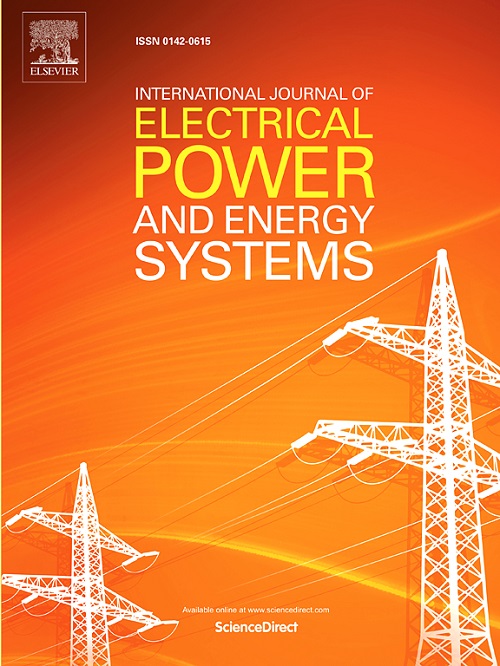Towards holonic power and energy systems – A novel ICT architecture as enabler for resilience
IF 5
2区 工程技术
Q1 ENGINEERING, ELECTRICAL & ELECTRONIC
International Journal of Electrical Power & Energy Systems
Pub Date : 2024-10-08
DOI:10.1016/j.ijepes.2024.110283
引用次数: 0
Abstract
In the ongoing transition towards distributed Renewable Energy Sources (RES) and the concurrent transformation of critical energy infrastructures, the efficient coordination of load, storage, and generation flexibilities while avoiding grid congestion is crucial. To orchestrate the growing myriad of distributed devices, digital solutions based on scalable information and communication technologies (ICT) that go far beyond the existing state-of-the-art, are the key enablers.
To open a new avenue towards robust and resilient power and energy systems, this paper proposes the concepts of holarchies and holonic structures as underlying design principles for grid automation and coordination of flexibilities in power and energy systems. We argue that the holonic concept and its theoretic underpinning enables designing and building future resilient power systems that can cope with the otherwise overwhelming complexities of the energy transition. Our long-term vision is that the proposed holonic concept encompasses already existing trends in power and energy systems, i.e. decentralization, digitalization as well as observability and controllability improvements, into one holistic framework, whereby holistic integration is likewise pun and serious ambition. Beyond the existing holonic approach in general and partly for limited power system applications so far, our design proposal encompasses ICT infrastructures and the data domain into a consistent novel architectural approach.
Holonic structures, or holarchies, extend and build upon the recursiveness and self-similarity of autonomous sub-structures, i.e. holons, of a system. It is a system-of-systems approach and, thus, conceptionally, very different from existing and well-known multi-agent system approaches. In essence, holonic concepts allow for the formalisation of hierarchical system relations regarding physics, information, and data using a part-whole architecture. Hence, they are well-suited for the conceptualisation of automation functionality across all dimensions of the cyber-physical domain of energy infrastructures and potentially also beyond.
This paper investigates holonic structures from different novel perspectives, such as control and automation, system modeling and digital twins, as well as the corresponding ICT-infrastructure and data requirements. Three case studies are drawn upon as examples to illustrate how holonic concepts and approaches are already emerging in power and energy systems operation.
© 2017 Elsevier Inc. All rights reserved.
迈向整体电力和能源系统--新型信息和通信技术架构助力复原力提升
在向分布式可再生能源(RES)过渡以及关键能源基础设施转型的过程中,有效协调负载、储能和发电的灵活性,同时避免电网拥塞至关重要。为了协调日益增长的大量分布式设备,基于可扩展的信息与通信技术(ICT)的数字解决方案是关键的推动因素,它远远超越了现有的最先进技术。为了开辟一条通往稳健而富有弹性的电力和能源系统的新途径,本文提出了整体和整体结构的概念,作为电网自动化和电力与能源系统灵活性协调的基本设计原则。我们认为,整体概念及其理论基础有助于设计和建设未来的弹性电力系统,以应对能源转型过程中难以承受的复杂性。我们的长远愿景是,所提出的整体概念将电力和能源系统的现有趋势,即分散化、数字化以及可观测性和可控性的改善,纳入一个整体框架,从而使整体整合成为同样重要的目标。除了现有的整体性方法(部分用于迄今为止有限的电力系统应用),我们的设计建议还将信息与通信技术基础设施和数据领域纳入到一种一致的新型架构方法中。它是一种系统的系统方法,因此在概念上与现有的众所周知的多代理系统方法截然不同。从本质上讲,整体概念允许使用 "部分-整体 "架构将物理、信息和数据方面的分层系统关系正规化。因此,整体概念非常适合于能源基础设施网络物理领域所有层面的自动化功能概念化,甚至有可能超越这些领域。本文从控制与自动化、系统建模和数字孪生等不同的新角度研究了整体结构,以及相应的信息与通信技术基础设施和数据要求。本文以三个案例研究为例,说明了整体化概念和方法是如何在电力和能源系统运行中出现的。保留所有权利。
本文章由计算机程序翻译,如有差异,请以英文原文为准。
求助全文
约1分钟内获得全文
求助全文
来源期刊
CiteScore
12.10
自引率
17.30%
发文量
1022
审稿时长
51 days
期刊介绍:
The journal covers theoretical developments in electrical power and energy systems and their applications. The coverage embraces: generation and network planning; reliability; long and short term operation; expert systems; neural networks; object oriented systems; system control centres; database and information systems; stock and parameter estimation; system security and adequacy; network theory, modelling and computation; small and large system dynamics; dynamic model identification; on-line control including load and switching control; protection; distribution systems; energy economics; impact of non-conventional systems; and man-machine interfaces.
As well as original research papers, the journal publishes short contributions, book reviews and conference reports. All papers are peer-reviewed by at least two referees.

 求助内容:
求助内容: 应助结果提醒方式:
应助结果提醒方式:


